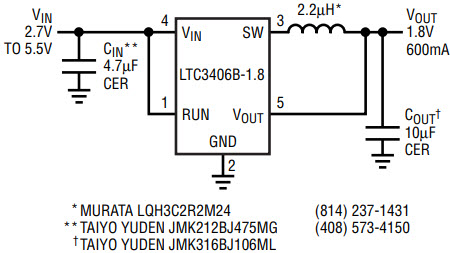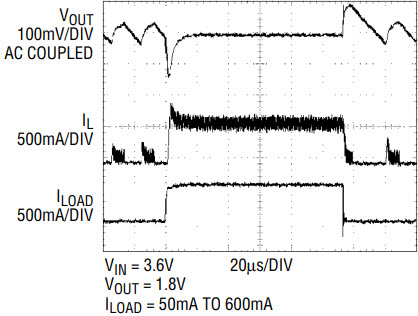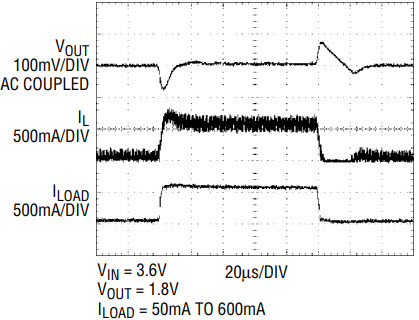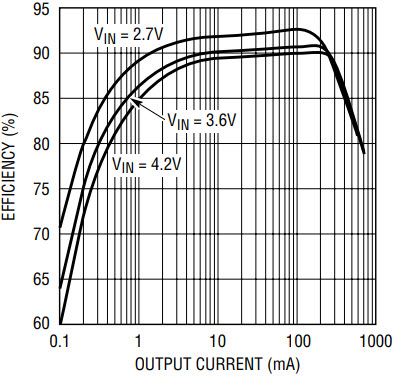Monolithic Synchronous Step-Down Regulators Pack 600mA Current Rating in a ThinSOT Package
Monolithic Synchronous Step-Down Regulators Pack 600mA Current Rating in a ThinSOT Package
by
Jaime Tseng
2002-08-01
Introduction
The new LTC3406, LTC3406-1.5, LTC3406-1.8, LTC3406B, LTC3406B1.5 and LTC3406B-1.8 are the industry’s first monolithic synchronous step-down regulators capable of supplying 600mA of output current in a 1mm profile ThinSOT package. These devices are designed to save space and increase efficiency for battery-powered portable devices. The LTC3406 series uses Burst Mode operation to increase efficiency at light loads, consuming only 20µA of supply current at no load. For noise-sensitive applications, the LTC3406B series disables Burst Mode operation and operates in pulse skipping mode under light loads. Both consume less than 1µA quiescent current in shutdown.
Space Saving
Everything about the LTC3406/LTC3406B series is designed to make power supplies tiny and efficient. An entire regulator can fit into a 5mm × 7mm board space. These devices are high efficiency monolithic synchronous buck regulators using a constant frequency, current mode architecture. Their on-chip power MOSFETs provide up to 600mA of continuous output current. Their internal synchronous switches increase efficiency and eliminate the need for an external Schottky diode. Internal loop compensation eliminates additional external components.
Versatile
These devices have a versatile 2.5V to 5.5V input voltage range, which makes them ideal for single cell Li-Ion or 3-cell NiCd and NiMH applications. The 100% duty cycle capability for low dropout allows maximum energy to be extracted from the battery. In dropout, the output voltage is determined by the input voltage minus the voltage drop across the internal P-channel MOSFET and the inductor resistance. The fixed voltage output versions—available for 1.5V and 1.8V—require no external voltage divider for feedback, further saving space and improving efficiency. The adjustable voltage output versions—the LTC3406 and LTC3406B—allow the output voltage to be externally programmed with two resistors to any value above the 0.6V internal reference voltage.
Fault Protection
The LTC3406 and LTC3406B protect against output overvoltage, output short-circuit and power overdissipation conditions. When an overvoltage condition at the output (>6.25% above nominal) is sensed, the top MOSFET is turned off until the fault is removed. When the output is shorted to ground, the frequency of the oscillator slows to 210kHz to prevent inductor-current runaway. The frequency returns to 1.5MHz when VFB is allowed to rise to 0.6V. When there is a power overdissipation condition and the junction temperature reaches approximately 160°C, the thermal protection circuit turns off the power MOSFETs allowing the part to cool. Normal operation resumes when the temperature drops to 150°C.
Efficient Burst Mode Operation (LTC3406 Series)
In Burst Mode operation, the internal power MOSFETs operate intermittently based on load demand. Short burst cycles of normal switching are followed by longer idle periods where the load current is supplied by the output capacitor. During the idle period, the power MOSFETs and any unneeded circuitry are turned off, reducing the quiescent current to 19µA. At no load, the output capacitor discharges slowly through the feedback resistors resulting in very low frequency burst cycles that add only a few microamperes to the supply current.
Pulse Skipping Mode (LTC3406B Series) for Low Noise
Pulse skipping mode lowers output ripple, thus reducing possible interference with audio circuitry. In pulse skipping mode, constant-frequency operation is maintained at lower load currents to lower the output voltage ripple. If the load current is low enough, cycle skipping eventually occurs to maintain regulation. Efficiency in pulse skipping mode is lower than Burst Mode operation at light loads, but comparable to Burst Mode operation when the output load exceeds 50mA.
1.8V/600mA Step-Down Regulator Using All Ceramic Capacitors
Figure 1 shows an application of the LTC3406/LTC3406B-1.8 using all ceramic capacitors. This particular design supplies a 600mA load at 1.8V with an input supply between 2.5V and 5.5V. Ceramic capacitors have the advantages of small size and low equivalent series resistance (ESR), making possible for very low ripple voltages at both the input and output. For a given package size or capacitance value, ceramic capacitors have lower ESR than other bulk, low ESR capacitor types (including tantalum capacitors, aluminum and organic electrolytics). Because the LTC3406/LTC3406B’s control loop does not depend on the output capacitor’s ESR for stable operation, ceramic capacitors can be used to achieve very low output ripple and small circuit size. Figures 2 and 3 show the transient response to a 50mA to 600mA load step for the LTC3406-1.8 and LTC3406B-1.8, respectively.

Figure 1. 1.8V/600mA step-down regulator using all ceramic capacitors.

Figure 2. LTC3406-1.8 transient response to a 50mA to 600mA load step.

Figure 3. LTC3406B-1.8 Transient Response to a 50mA to 600mA Load Step.
Efficiency Considerations
Figure 4 shows the efficiency curves for the LTC3406-1.8 (Burst Mode operation enabled) at various supply voltages. Burst Mode operation significantly lowers the quiescent current, resulting in high efficiencies even with extremely light loads.

Figure 4. Efficiency vs Load Current for LTC3406-1.8.
Figure 5 shows the efficiency curves for the LTC3406B-1.8 (pulse skipping mode enabled) at various supply voltages. Pulse skipping mode maintains constant-frequency operation at lower load currents. This necessarily increases the gate charge losses and switching losses, which impact efficiency at light loads. Efficiency is still comparable to Burst Mode operation at higher loads.

Figure 5. Efficiency vs Load Current for LTC3406B-1.8.




















